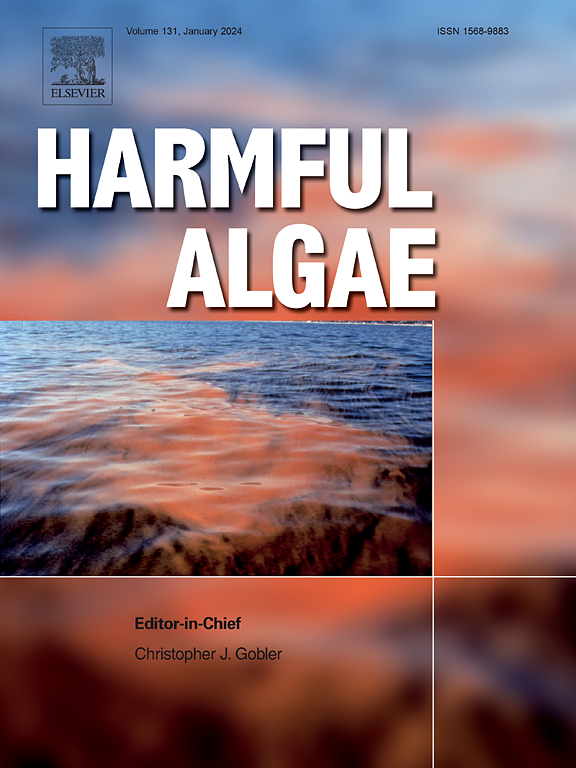新喀里多尼亚(西南太平洋)波利尼西亚甘比铁鱼:形态分子特征、毒素谱和对光强的反应
IF 4.5
1区 生物学
Q1 MARINE & FRESHWATER BIOLOGY
引用次数: 0
摘要
冈比亚铁饼已知产生与雪卡毒素中毒(CP)相关的神经毒素。在西南太平洋的新喀里多尼亚(NC),目前关于CP和与这种食源性疾病相关的微藻的知识差距很大。本文报道了一株分离自美国西海岸的波利尼西亚甘比铁圆盘菌(Gambierdiscus polynesiensis) 19PV93。分离培养菌株进行形态分子鉴定,确定其系统发育位置。使用神经母细胞瘤细胞(CBA-N2a)细胞为基础的测定法评估毒性活性,并使用液相色谱-串联质谱(LC-MS/MS)表征毒素谱,以评估对人类健康的潜在风险。关于毒素谱,波利尼西亚赤霉素的特征是存在甘比酮,44-甲基甘比酮(44-MeG),以及仅由雪卡毒素- 4a (CTX4A)和-4B (CTX4B)组成的非典型雪卡毒素谱。这一发现证实了来自不同地理来源的菌株之间毒素谱的种内差异。在培养中,波利尼西亚人表现出对相对较低的辐照度(50到100 μ mol光子m⁻²s⁻¹)的偏好,而在自然环境中经常遇到较高的光强度。发现光对毒素浓度的影响与光强成反比,在较低的光水平下观察到较高的配额。Gambierdiscus采用非光化学猝灭作为光保护策略来保护PSII免受过度光照,特别是在短期和长期照射下。然而,单靠这种耗散策略似乎是不够的,因为光抑制一直存在,并且随着光强的增加,电子转移速率和产率沿着电子转移链迅速下降。本文章由计算机程序翻译,如有差异,请以英文原文为准。

Gambierdiscus polynesiensis from New Caledonia (South West Pacific Ocean): Morpho-molecular characterization, toxin profile and response to light intensity
Gambierdiscus is known to produce neurotoxins associated with ciguatera poisoning (CP). In New Caledonia (NC), South West Pacific Ocean, there is currently a significant knowledge gap regarding CP and the microalgae linked to this foodborne illness. This study describes a new strain of Gambierdiscus polynesiensis, 19PV93, isolated from the west coast of NC. The strain was isolated and cultured for morpho-molecular characterization to determine its phylogenetic position. Toxic activity was assessed using a cell-based assay with neuroblastoma cells (CBA-N2a), and the toxin profile was characterized using liquid chromatography coupled with tandem mass spectrometry (LC-MS/MS) to evaluate potential risks to human health. Regarding the toxin profile, G. polynesiensis was characterized by the presence of gambierone, 44-methylgambierone (44-MeG), and an atypical ciguatoxin profile consisting solely of ciguatoxin-4A (CTX4A) and -4B (CTX4B). This finding confirms intraspecific variations in toxin profiles between strains from different geographic origins. In culture, G. polynesiensis demonstrated a preference for relatively low irradiances (50 to 100 µmol photons m⁻² s⁻¹) compared to the higher light intensities often encountered in their natural environment. The impact of light on toxin concentrations was found to be inversely related to light intensity, with higher quotas observed at lower light levels. Gambierdiscus employed non-photochemical quenching as a photoprotective strategy to safeguard PSII from excessive light, particularly during both short-term and long-term exposure. However, this dissipation strategy alone appears insufficient, as photoinhibition was consistently observed, and the electron transfer rate and yield along the electron transfer chain rapidly declined with increasing light intensity.
求助全文
通过发布文献求助,成功后即可免费获取论文全文。
去求助
来源期刊

Harmful Algae
生物-海洋与淡水生物学
CiteScore
12.50
自引率
15.20%
发文量
122
审稿时长
7.5 months
期刊介绍:
This journal provides a forum to promote knowledge of harmful microalgae and macroalgae, including cyanobacteria, as well as monitoring, management and control of these organisms.
 求助内容:
求助内容: 应助结果提醒方式:
应助结果提醒方式:


